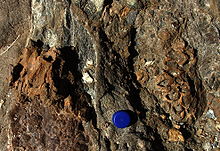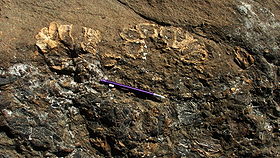- Megabalanus
-
Megabalanus
Temporal range: Miocene–RecentFossilised M. tintinnabulum(?), showing a side-on (left) and top-down (right) view. Bottle lid for scale (2 cm diameter) Scientific classification Kingdom: Animalia Phylum: Arthropoda Subphylum: Crustacea Class: Maxillopoda Subclass: Thecostraca Infraclass: Cirripedia Order: Sessilia Family: Balanidae Genus: Megabalanus
Hoek, 1913 [1]Species - Megabalanus californicus (Pilsbry, 1916)
- Megabalanus coccopoma (Darwin, 1854)
- Megabalanus stultus (Darwin, 1854)
- Megabalanus tanagrae (Pilsbry, 1928)
- Megabalanus tintinnabulum (Linnaeus, 1758)
Megabalanus is a genus of barnacle. It grows to 7 centimetres (2.8 in) in length, and inhabits the lower intertidal zone.
Contents
Morphology
Megabalanus is an acorn barnacle comprising an organism dwelling in a calcium carbonate shell consisting of five plates. It reaches up to 7 cm (2.8 in) in height [2][3][4].
Ecology
Just like other barnacles, they are suspension feeders, grabbing particulate matter from the water column overhead. M. tintinnabulum has a worldwide distribution and is commonly found on wave-beaten shores, in the lower intertidal zone.[4] The organisms tend to grow in clusters of around a dozen individuals. Other species are more select, like M. californicus of tidal habitats in California and the greater North American Pacific coast.
While many barnacles deal with competition for space by organisms such as limpets and mussels by growing many organisms close together in colonies, Megabalanus responds by rapidly growing to a very large size [4]. Their large size also helps reduce predation - although it makes them large enough to be harvested for human consumption.
Etymology
The generic name Megabalanus literally translates as "large barnacle".
Surprisingly, the specific name tintinnabulum does not refer to the Tintin character Captain Haddock, whose catchphrase was "Blistering barnacles"; it was designated by 18th century taxonomist Linnaeus and refers to the animal's shape — a tintinnabulum is a handbell [5].
Geological utility
Fossilised specimens of Megabalanus have been found dating back to the Miocene [4]. Fossils bearing a close resemblance to M. tintinnabulum are preserved in large numbers in the Tabernas Basin of Spain. A case study of this area showed that the state of preservation of the organisms makes it possible to estimate the distance they were transported post mortem. Since the species today lives in the intertidal zone, this allows an estimate to be made of the distance from the shoreline, and by implication the water depth. These observations are backed up by the appearance of the deep water trace fossil Zoophycum in the predicted deepest waters, suggesting that barnacles can be a good proxy for water depth.
References
- ^ "Megabalanus". Integrated Taxonomic Information System. http://www.itis.gov/servlet/SingleRpt/SingleRpt?search_topic=TSN&search_value=89657.
- ^ B. A. Foster (1987). "Barnacle ecology and adaptation". In A. J. Southward. Crustacean Issues V. Barnacle Biology. Balkema, Rotterdam. pp. 113–133. ISBN 90-6191-628-3.
- ^ B. A. Foster & J. S. Buckeridge (1987). "Barnacle palaeontology". In A. J. Southward. Crustacean Issues V. Barnacle Biology. Balkema, Rotterdam. pp. 43–62. ISBN 90-6191-628-3.
- ^ a b c d P. Doyle; A. E. Mather, M. R. Bennett & A. Bussell (1997). "Miocene barnacle assemblages from southern Spain and their palaeoenvironmental significance". Lethaia 29 (3): 267–274. doi:10.1111/j.1502-3931.1996.tb01659.x.
- ^ D. P. Henry & P. A. McLaughlin (1986). "The Recent species of Megabalanus (Cirripedia: Balanomorpha) with special emphasis on Balanus tintinnabulum (Linnaeus) sensu lato". Zoologische Verhandelingen 235: 1–69. http://www.repository.naturalis.nl/record/317744.
Categories:- Barnacles
- Fossils
Wikimedia Foundation. 2010.


